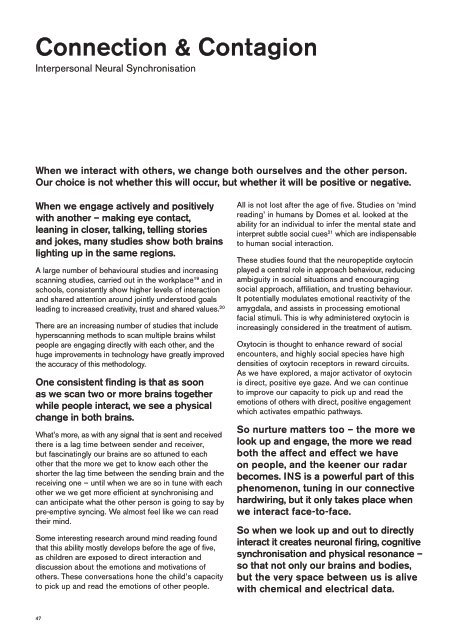THE ART AND SCIENCE OF LOOKING UP REPORT
You also want an ePaper? Increase the reach of your titles
YUMPU automatically turns print PDFs into web optimized ePapers that Google loves.
Connection & Contagion<br />
Interpersonal Neural Synchronisation<br />
Study 2.0<br />
A<br />
Neuroscience<br />
Crash-course<br />
B<br />
Set-up<br />
Pre-class Baseline<br />
Facing<br />
Wall<br />
Facing<br />
Pairs<br />
Teacher<br />
Reads Aloud<br />
Video<br />
Classroom EEG Recordings (11 days)<br />
Teacher<br />
Lectures<br />
Group<br />
Discussion<br />
Post-class Baseline<br />
Facing<br />
Wall<br />
Facing<br />
Pairs<br />
10 min 2 min 2 min 3 min 2 min 3 min 5 min 2 min 2 min<br />
D<br />
Student-led<br />
Research Project<br />
1 2<br />
When we interact with others, we change both ourselves and the other person.<br />
Our choice is not whether this will occur, but whether it will be positive or negative.<br />
C<br />
Students<br />
1 2<br />
1<br />
2<br />
Total Interdependence<br />
Student 1-2<br />
1 2<br />
When we engage actively and positively<br />
with another – making eye contact,<br />
leaning in closer, talking, telling stories<br />
and jokes, many studies show both brains<br />
lighting up in the same regions.<br />
A large number of behavioural studies and increasing<br />
scanning studies, carried out in the workplace 19 and in<br />
schools, consistently show higher levels of interaction<br />
and shared attention around jointly understood goals<br />
leading to increased creativity, trust and shared values. 20<br />
There are an increasing number of studies that include<br />
hyperscanning methods to scan multiple brains whilst<br />
people are engaging directly with each other, and the<br />
huge improvements in technology have greatly improved<br />
the accuracy of this methodology.<br />
One consistent finding is that as soon<br />
as we scan two or more brains together<br />
while people interact, we see a physical<br />
change in both brains.<br />
What’s more, as with any signal that is sent and received<br />
there is a lag time between sender and receiver,<br />
but fascinatingly our brains are so attuned to each<br />
other that the more we get to know each other the<br />
shorter the lag time between the sending brain and the<br />
receiving one – until when we are so in tune with each<br />
other we we get more efficient at synchronising and<br />
can anticipate what the other person is going to say by<br />
pre-emptive syncing. We almost feel like we can read<br />
their mind.<br />
Some interesting research around mind reading found<br />
that this ability mostly develops before the age of five,<br />
as children are exposed to direct interaction and<br />
discussion about the emotions and motivations of<br />
others. These conversations hone the child’s capacity<br />
to pick up and read the emotions of other people.<br />
All is not lost after the age of five. Studies on ‘mind<br />
reading’ in humans by Domes et al. looked at the<br />
ability for an individual to infer the mental state and<br />
interpret subtle social cues 21 which are indispensable<br />
to human social interaction.<br />
These studies found that the neuropeptide oxytocin<br />
played a central role in approach behaviour, reducing<br />
ambiguity in social situations and encouraging<br />
social approach, affiliation, and trusting behaviour.<br />
It potentially modulates emotional reactivity of the<br />
amygdala, and assists in processing emotional<br />
facial stimuli. This is why administered oxytocin is<br />
increasingly considered in the treatment of autism.<br />
Oxytocin is thought to enhance reward of social<br />
encounters, and highly social species have high<br />
densities of oxytocin receptors in reward circuits.<br />
As we have explored, a major activator of oxytocin<br />
is direct, positive eye gaze. And we can continue<br />
to improve our capacity to pick up and read the<br />
emotions of others with direct, positive engagement<br />
which activates empathic pathways.<br />
So nurture matters too – the more we<br />
look up and engage, the more we read<br />
both the affect and effect we have<br />
on people, and the keener our radar<br />
becomes. INS is a powerful part of this<br />
phenomenon, tuning in our connective<br />
hardwiring, but it only takes place when<br />
we interact face-to-face.<br />
So when we look up and out to directly<br />
interact it creates neuronal firing, cognitive<br />
synchronisation and physical resonance –<br />
so that not only our brains and bodies,<br />
but the very space between us is alive<br />
with chemical and electrical data.<br />
E<br />
Researcher<br />
Teacher<br />
5<br />
3<br />
4<br />
01 No Synchrony 02 Group Synchrony 03 Student-to-Group<br />
Synchrony<br />
04 Student-to-Student<br />
Synchrony<br />
A study observing high school children interacting in a classroom setting showed the neural magic<br />
that happens when people engage warmly and share excitement. In the study by Dicker et al, EEG was<br />
recorded from 12 students simultaneously over 11 sessions, showing that the level of synchrony<br />
created consistently predicted both classroom engagement and the social dynamics seen in the class,<br />
suggesting that this relationship may be driven by shared attention within the group, and by the amount<br />
of eye contact face-to-face the students had.<br />
Specifically, there was an increase in synchronisation between the students in an interactive, positive<br />
environment with shared attention – tying in with long standing behavioural evidence showing that people<br />
physically, and typically subconsciously, synchronise with each other when engaging in tasks that require<br />
joint attention (pupil dilation, gestures, walking vocal rhythm and emotional level). There are neural<br />
studies showing that brain rhythms lock to the rhythms of auditory and audiovisual input, and the higher<br />
the level of shared attention to the stimulus, the stronger the synchronisation. Shared student focus<br />
predicted student to group synchrony independent of teaching style, but the more the students liked the<br />
teacher, the greater the level of neural attention and subsequent group synchronisation.<br />
Direct eye gaze made a difference. To test student interaction effects, some students had to engage in two<br />
minutes of direct eye contact just before class. The researchers then monitored three things – having had<br />
eye contact, sitting adjacent to each other and not sitting adjacent. The variable that made a difference was<br />
direct eye contact before class, which raised reported social closeness, directly increased brain-to-brain<br />
synchrony during class and served as an ‘‘activator’’ for actual joint attention, and not passive co-presence.<br />
3<br />
4<br />
5<br />
Total Interdependence<br />
Student 3-4<br />
1 2<br />
Total Interdependence<br />
Student 1-5<br />
47<br />
48















